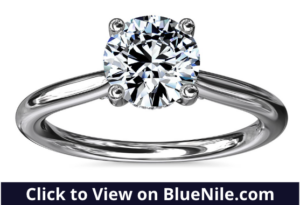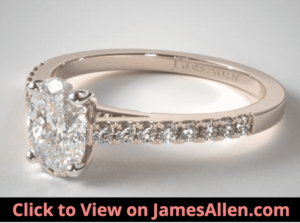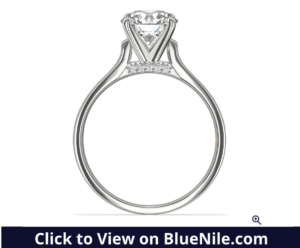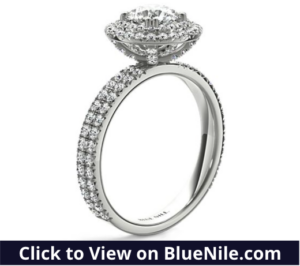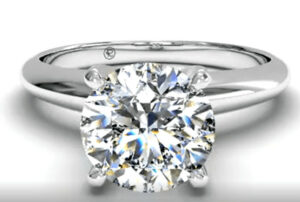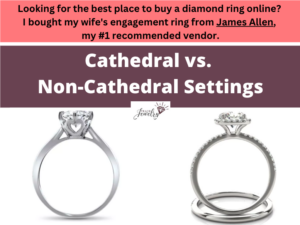
There are many types of settings for diamond rings, and one way to classify them is as a cathedral or non-cathedral setting.
The main difference between cathedral and non-cathedral settings is that cathedral settings have an arch that extends from the top of the shank to hold the diamond high above the ring. Non-cathedral settings don’t have this arch, so the diamond is often placed closer to the ring.
When I was shopping for my wife’s engagement ring, I explored dozens of styles of settings, including a variety of cathedral and non-cathedral settings. I landed on a non-cathedral solitaire setting, which was a knife edge ring with a round-cut diamond on top.
Let’s compare cathedral versus non-cathedral settings, including an overview of each, their pros and cons, and how to decide which is right for you.
What is a Cathedral Setting?
A cathedral setting features two arches that form the shape of a cathedral building when they extend up from the shank to hold the diamond. It creates triangle gaps in the setting. At the top, prongs often secure the diamond, supported by the cathedral arches.
Check out this stunning cathedral setting, from the vendor where I bought my wife’s engagement ring, that also includes pave lining the shank.
It’s a solitaire, but the distinguishing feature is located at the top of the shank, where it breaks from the traditional style and slopes upward.
Notice the two holes those arches create.
Cathedral settings aren’t limited to prongs because the design only refers to the slope of the band, not the entire setting.
Whether you choose a tension or bezel setting, the arches can still rise from the band to meet the metal holding the diamond.
In most cases, cathedral settings result in a high-set diamond.
Here’s a cathedral setting with a hidden halo and basket that provides the perfect example.
The diamond sits higher off the band and your finger compared to other types.
It’s only when you view it from the profile that the hidden halo and basket becomes visible.
There are unique designs where the diamond sits low, but traditional cathedral settings give it more prominence.
Pros
Prominently Displays Diamond
Settings are often judged based on how well they display the diamond. High-set cathedrals score well in this area because the diamond is elevated from the shank to make it appear larger.
It maximizes the amount of light that enters the diamond to enhance its brilliance, which also minimizes the visibility of inclusions.
In the example below, the diamond sits far higher off the ring than in most non-cathedral settings.
Available in Multiple Styles
Another benefit of cathedral settings is the variety of designs.
As long as the sloped arches are still present, this setting can include a number of additions, such as milgrain on the ring or several rows of pave diamonds.
Although I ended up choosing a solitaire setting, I considered a style resembling this design. There’s something about complementing a diamond with an elegant cathedral, in addition to diamonds lining the shank, that creates a truly stunning ring.
You can also add bead-set or channel set accents to the shank.
Cathedral settings are available with thin bands and solitaire settings, where the only focus is the center diamond. If you’ve chosen a large, eye-clean diamond, I recommend not crowding it with too many other designs.
A simple cathedral setting maximizes its display and light performance.
Pairs Well with Wedding Rings
The setting also fits well with a wedding ring.
A reason many buyers choose a cathedral setting is because the wedding ring can slide underneath the high setting.
Instead of competing with each other because both settings are low, the engagement ring and wedding ring will complement each other.
Unique
The last advantage of cathedral settings is their uniqueness. The majority of settings don’t include the arches, so this option allows you to find an alternative from the traditional design in a way that isn’t tacky.
Instead, it offers a sense of elegance in how it displays the diamond.
Here’s the perfect example.
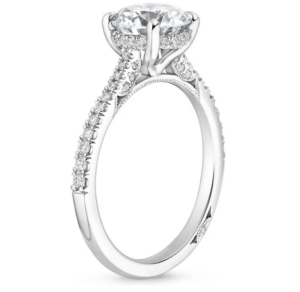
The design is simplistic and clean but offers more than a standard solitaire. It includes pavé, a common embellishment, but the diamonds rise across the arches leading up to the center diamond.
It adds intricate detail to the piece without overwhelming the main diamond.
Cons
Diamond is More Vulnerable
For ones with a high-set design, it leaves the diamond more susceptible to hits and chips. This is countered by the strong security of a cathedral setting, but it puts the diamond in a vulnerable position.
Notice how high the diamond sits on this cathedral setting.
You should remove the piece of jewelry during physical activity where it could experience hard impact.
Cathedral settings are also more liable to snag on furniture, hair, or clothing.
Accumulates Debris
This trait lead to another downside. The crevices in cathedral settings can fill with debris and dirt, which means it’ll need cleaning more often than non-cathedral settings.
I recommend you take it to a professional jeweler once or twice per year to remove the grime that accumulates.
Distracts from Center Diamond
The unique design of a cathedral can also be an issue. Most buyers want the focus on the diamond itself, and the elegant, sloped appearance of a cathedral setting can distract from the center diamond.
Ensure you approve of its design before choosing it for an engagement ring.
What is a Non-Cathedral Setting?
Non-cathedral settings don’t include the cathedral arches sloping upward to hold the diamond.
It isn’t an official term to describe a setting but instead generally refers to a ring where the prongs extend from the shank from one point.
Notice that trait on this four-prong setting in rose gold.
All four converge to around the same point at the top of the shank, creating a tight aesthetic.
It’s often called a floating setting or described as one where the diamond rests on top.
As the band approaches the top of your finger on each side, it doesn’t break off into two parts to form the cathedral arches.
This results in less metal surrounding the diamond.
Pros
Simplistic
The main benefit is a simplistic design that minimizes the amount of metal on the piece.
I’ve seen designs that appear too bulky, where the diamond itself just doesn’t stand out like it should. Diamonds cost too much money to be hidden by its setting.
The sloped metal on cathedral settings can also block the profile view of the diamond. When you’re showing off your diamond ring, it won’t always be from the top-down view.
Be mindful of its appearance from every angle.
By choosing a non-cathedral setting, you provide more visibility to the diamond and allow light to hit it from every side.
Variety
There are also more varieties of non-cathedral settings versus cathedral.
Nearly all of the designs for a cathedral setting, from pavé and channel set diamond accents to solitaires and double halos, are available in a floating setting.
For example, check out this double halo in platinum.
Its total carat weight is 7/8, and there’s a double row of pavé extending almost all the way around the piece.
I recommend exploring your options at an online jeweler. Many allow you to mix and match settings and diamonds, so you can learn which combination is right for you.
Easier to Clean
Many of these options also don’t accumulate debris or snag as easily. If you opt for a solitaire setting where the diamond rests on top, cleaning the ring doesn’t always require a professional.
In fact, I’ve always just cleaned my wife’s engagement ring at home because of its simple design. I don’t have to worry about dislodging pave diamonds or milgrain.
There are fewer spaces for dirt to get stuck, so the design gives it an advantage.
Many non-cathedral settings, such as trellis settings, sit lower compared to cathedral designs. It lessens the chance of it getting caught on everyday items. A low-set diamond is also better protected.
I should clarify that you can still have a high-set, non-cathedral setting or a cathedral setting with a low profile. But as a general rule, non-cathedral settings don’t position the diamond at the same height.
Cons
Some Designs Lack Elegance
If you’re considering a floating style, the simplistic design may not appeal to you.
Instead, you may want the structure provided by a cathedral setting and the way it secures the diamond.
Cathedral settings provide a degree of elegance not found in many other types of setting.
From conversations I’ve had with prospective buyers, I’ve learned there are generally two perspectives. Some place all their attention on choosing the center diamond, and others are more concerned with the overall appearance of the ring.
Neither is right or wrong, but if you’re focused on how the diamond is displayed, cathedral settings are an exceptional choice because of the prominence it gives the diamond.
They don’t require additional diamonds to enhance its appearance, while some buyers find non-cathedral settings too plain, such as a simple knife edge ring.
Many buyers who choose a non-cathedral setting look for ways to enhance other parts of the band.
Diamond Sits Lower
Floating style settings or ones where the diamond rests on top often sit lower compared to cathedral settings.
It may interfere with the wedding ring and not slide under it as easily.
I also often tell buyers to choose a high setting for large diamonds, so a cathedral setting can be the right fit in many cases.
A high versus low setting isn’t always the right or wrong choice, but it’s worth considering which option is right for your ring.
How to Decide Between Cathedral and Non-Cathedral Ring Settings
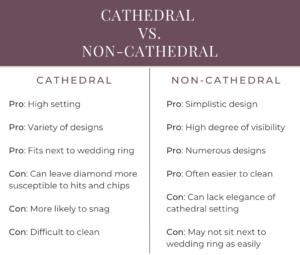
If you’re deciding between a cathedral versus non-cathedral setting, you should know which characteristics in a setting are most important to you.
Here are some tips.
Choose a cathedral setting if:
- The arched design and triangle gaps are appealing to you
- You have a large center diamond
- You prefer the prominence of a high setting that better displays the diamond
- You want to maximize the amount of light that can enter the diamond from the top
Opt for a non-cathedral setting if:
- You don’t prefer the appearance of sloped arches leading to the diamond
- You want to choose from a variety of options such as traditional bezel or tension settings
- You’re concerned the prongs on a high setting could snag
- Keeping the setting free of debris and grime is important to you
Many online retailers allow you to view images of how your diamond would look in a particular setting.
By comparing how your diamond is showcased by cathedral and non-cathedral settings, you’ll find the right setting for you.

Jacob Clarke
Jacob Clarke is the founder of TeachJewelry.com.
He earned an Applied Jewelry Professional Diploma from the Gemological Institute of America (GIA) and now brings you essential information about diamonds, settings, and more.
Jacob has consulted with leading jewelry brands, and his work has been cited in Clean Origin, Diamond Nexus and industry publications.
He's also a member of the International Gem Society.
He enjoys discussing jewelry with readers, so contact him with any questions at jacob.clarke@teachjewelry.com.

